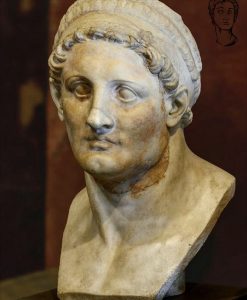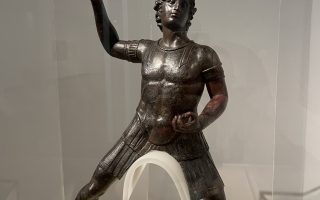How many Ptolemies were there? Why was Cleopatra number seven? Where did the custom of brother‑sister marriage come from? This guides delves into the Ptolemaic dynasty who ruled over Egypt from the early years after Alexander’s death in 323 BC until the fall of Cleopatra in 31 BC. Distinct aspects of Ptolemaic rule will be looked into as well as specific rulers and their accomplishments. This guide will be expanding as more posts on the Ptolemies will be added to the account, so be sure to check back!
Ptolemy I Soter (323‑285 BC)

Ptolemy I was one of Alexander’s generals who after his death warred with the other diadiochi over Alexander’s empire. He was the first king and founder of the Ptolemaic dynasty ruling over Egypt from 323 to 285 BC.
He grew up at the Macedonian court and became a close adviser of Alexander, supporting him on his claim to the Macedonian throne and serving in important positions during Alexander’s conquests of the East. He fought at Issos in 333 BC and helped Alexander found Alexandria. After Alexander’s death, at first Ptolemy acknowledged the rule of Alexander IV and Philip Arrhidaios but claimed the satrapy of Egypt. He fought with the other successors Lysimachos, Antigonos and Seleucos for control over Alexander’s empire. He clashed with Cleomenes of Naucratis over the rule of Egypt but had him executed in 321 BC. From 306 to 286 BC, Ptolemy expanded his empire by gaining control over Cyrene, Palestine, Cyprus and the Syrian coast. In 286 BC, he extended his influence to include the Cycladic islands and Delos.
Ptolemy married three times and had two children with Berenike, Arsinoe II en Ptolemy II, who deified him as Ptolemy Soter after his death in 283 BC. Ptolemy made sure that throughout his empire the administration was solid and founded the city Ptolemais. He wrote a history of Alexander’s life and campaigns which is partly preserved in Arrian’s Anabasis.
Silver tetradrachm, Ptolemy I

It was minted around 300 BC, during the reign of Ptolemy I Soter (305‑282 BC), most likely in Alexandria. The obverse shows the diademed head of Ptolemy I right, in aegis and a small Δ behind ear. The reverse has the inscription ΠTOΛEMAIOY BAΣIΛEΩΣ surrounding the eagle on a thunderbolt; P and a monogram to the left. This eagle was first adopted by Ptolemy I and soon became a common symbol of the Ptolemaic dynasty.
Ptolemaic coins were issued in silver, gold and bronze and used the Phoenician standard which was lighter than the Attic one and used in a lot of other Hellenistic states. During most of the Ptolemaic Kingdom’s history, it was a policy that all foreign coinage within Egypt would be confiscated by the state and replaced with Ptolemaic currency. Parallels between Athens and the Ptolemaic Kingdom can be drawn as Athens attempted to introduce a sole currency in its empire.
Ptolemy I and Berenike

A gold tetradrachm issued by the Ptolemaic king Ptolemy II Philadelphos. The obverse is shown here depicting Philadelphos’ parents Ptolemy I and Berenike as divine gods, hence the inscription ΘΕΩΝ. The reverse, which is not depicted here shows Ptolemy II Philadelphos with his wife and sister Arsinoe II and the inscription ΑΔΕΛΦΩΝ. This coin was issued to celebrate their partnership and joint rule (276‑270 BC).
Ptolemy II Philadelphus (283-246 BC)

This gold tetradrachm shows Ptolemy II Philadelphus on the obverse and an eagle surrounded by the inscription ΠΤΟΛΕΑΙΟΥ ΒΑΣΙΛΕΩΣ. He ruled over Egypt from 283 to 246 BC. Ptolemy married his sister Arsinoe II, after the banishment of his first wife Arsinoe I, the daughter of Lysimachus. Profiting from the internal weaknesses in the other Hellenistic kingdoms, Ptolemy was able to expand his rule into Syria, Asia Minor an the Aegean. But Ptolemy wasn’t always successful in his military endeavors: he unsuccessfully tried to coax the Greeks against Macedon in the Chremonidean War and he did not fare so well during the Second Syrian War. Yet his diplomatic genius saved him many times.
Domestically, Ptolemy II stabilized the Ptolemaic Empire, improving the economy and the administration. Under his rule, agriculture and commerce were further developed and Alexandria served as a main trading and export centre. He built temples and established a ruler‑cult for his parents as well as himself and his sister wife. They were known as the theoi adelphoi, the first example of a Hellenistic ruler cult.
He also surrounded himself with famous poets and scientists such as Callimachus and Apollonius of Rhodes. He funded the Museum, a research institution which included the famed library of Alexandria. His rule happened at the height Hellenistic civilization and under Ptolemy, the culture and literary influence of the Alexandrian court was at it highest.
Coin showing Arsinoe II (316‑270/260 BC)

This coin shows Arsinoe II. Arsinoe II was the daughter of Ptolemy I Soter and became the queen of Thrace, Macedon and Anatolia through her marriage to Lysimachus and queen of the Ptolemaic Empire via her marriage with her brother Ptolemy II. She had a big political influence in both of her marriages and was an example for subsequent Ptolemaic queens.
She was raised in Alexandria and in 299 BC she married Lysimachos, most likely to solidify an alliance with the king. She had three sons with him and in order to secure the throne for them Arsinoe is said to have turned Lysimachos against him, leading to his execution in 283/3 BC. After his Lysimachos’ death in 281 BC, Arsinoe fled to the city of Cassandreia and married her half‑brother Ptolemy Keraunos. This destastrous marriage was most likely arranged for political reasons and would eventually lead to the death of two of her sons to seek protect protection from her younger brother Ptolemy II.
Once there, she married her brother, after possibly having his first wife Arsinoe I exiled. Together with her brother – they were known as the Philadelpoi – Arsinoe actively took part in her brother’s rule. She had her own ruler cult, was a patron of the arts, shared in all of her brother’s titles, had towns dedicated to her, coins were minted in her image and she contributed to political victories. She died at some point between 270 and 260 BC. After her death she was deified by her husband as Arsinoe Philadelphus.
Coins showing Berenike II and Arsinoe III

Two coins depicting important Ptolemaic women side by side. On the left: an oktodrachm depicting Arsinoe III, the wife of Ptolemy IV, dated to 204‑203 BC. She was the queen between 220 and 204 BC and was the first queen to have children with her own brother. On the coin on the right: Arsinoe’s mother Berenike II who was queen of Egypt between 246 and 222 BC, together with her husband Ptolemy III.
Ptolemy III Euergetes (246‑222 BC)

A striking portrait of Ptolemy III Euergetes (264‑222 BC) which can be found in the Vatican Museum in Rome. He was the son of Ptolemy II and Arsinoe I. When he became king, he married Berenice of Cyrenaica adding this area to the Ptolemaic kingdom.
Just as other Ptolemaic kings, Ptolemy III fought against the Seleucids, in the Third Syrian War (246‑241 BC). He was able to invade their empire and was victorious but was forced to abandon the campaign as a result of an uprising in Egypt. As a result of this, Ptolemy forged a closer bond with the Egyptian priestly elite, which was recorded in the Canopus decree of 238 BC, solidifying the Ptolemaic rule of Egypt.
In the Aegean, Ptolemy suffered heavy because his fleet was defeated by the Antigonids at the Battle of Andros in 245 BC. Yet he continued to offer financial support to anti‑Antigonid rulers in mainland Greece for the rest of his reign.
Head of Arsinoe III? (246‑204 BC)

Head of a Ptolemaic Queen, possibly Arsinoe III (246‑204 BC), the daughter of Ptolemy II and Berenike II. Like many of the Ptolemaic queens, she was married and had children with her own brother Ptolemy IV Philopator.
As the queen she was very active in the political scene of the age and is said to have accompanied her husband to the battle of Raphia in 217 BC. In 204 BC she was murdered by her husbands two confidant Sosibius and Agathocles as they feared she would succeed her husband after his death.
Ptolemy IV Philopator (222‑205 BC)

This golden octodrachm was minted during the reign of Ptolemy IV Philopater and shows the radiated and diademed head of the deified Ptolemy III on the obverse, while the reverse shows the radiated cornucopia bound with royal diadem surrounded by the inscription ΒΑΣΙΛΕΩΣ ΠΤΟΛΕΜΑΙΟΥ. This cornucopia was also a recurring symbol on Ptolemaic coins.
His rule was marked by the Fourth Syrian War (219–217 BC) with the Seleucids which ended in a decisive Ptolemaic victory at the Battle of Raphia, one of the largest battles of the Hellenistic Age. In the last years of his reign, Ptolemy lost control over the southern portion of the country to the rebel Pharaoh Hugronaphor. In 204 BC the king died in mysterious circumstances and was succeeded by his young son Ptolemy V Epiphanes.
In ancient sources, Ptolemy was criticized for being more interested in luxury and court ceremony than government, politics, and foreign relations. The decline of the Ptolemaic dynasty is usually traced to his reign.
Head of Cleopatra VII (69‑31 BC)

This is a buste of Cleopatra VII. The head is made from marble dated to 40‑30 BC and was found along the Via Appia. Cleopatra is shown wearing the traditional broad royal diadem of the Ptolemaic dynasty and her hair is pulled back in the melon hairstyle with bun in the neck. The portrait of the queen was made during her lifetime and most likely set up in an Italian villa.
Cleopatra VII Philopater was the daughter of Ptolemy XII and the last pharao and ruler of the Ptolemaic kingdom. Born in 69 BC, Cleopatra and her brother Ptolemy XIII became co‑regent of Egypt after the death of their father in 51 BC. As was the tradition with the Ptolemies, she married her brother and they ruled together. However, they soon turned on one another and Cleopatra was banished. Three years later, Pompey who had lost the civil war to Caesar, fled to Egypt and was murdered by Ptolemy.
Taking advantage of Caesar’s anger at this act, Cleopatra used this to gain his support and had her brother killed. In 47 BC, she gave birth to Caesarion, her son with Caesar. Her rule brought stability to the a torn Egypt and she even learned Egyptian.
When Caesar died, Cleopatra started a relationship and had three children with Marc Anthony, who married to Octavian’s sister. This caused a tension between the men, which escalated to a full out civil war. Together they ruled over the eastern part of the empire until they were beaten in battle on the coast of Greece where the two armies faced each other. Cleopatra and Marc Anthony fled back to Egypt, but Octavian pursued them and they eventually killed themselves when Alxandria was conquered in 30 BC.
What do you think of the Ptolemies? Who is your favourite ruler? What do you think about the Ptolemaic queens and their role in society? Get in touch in the comments!




